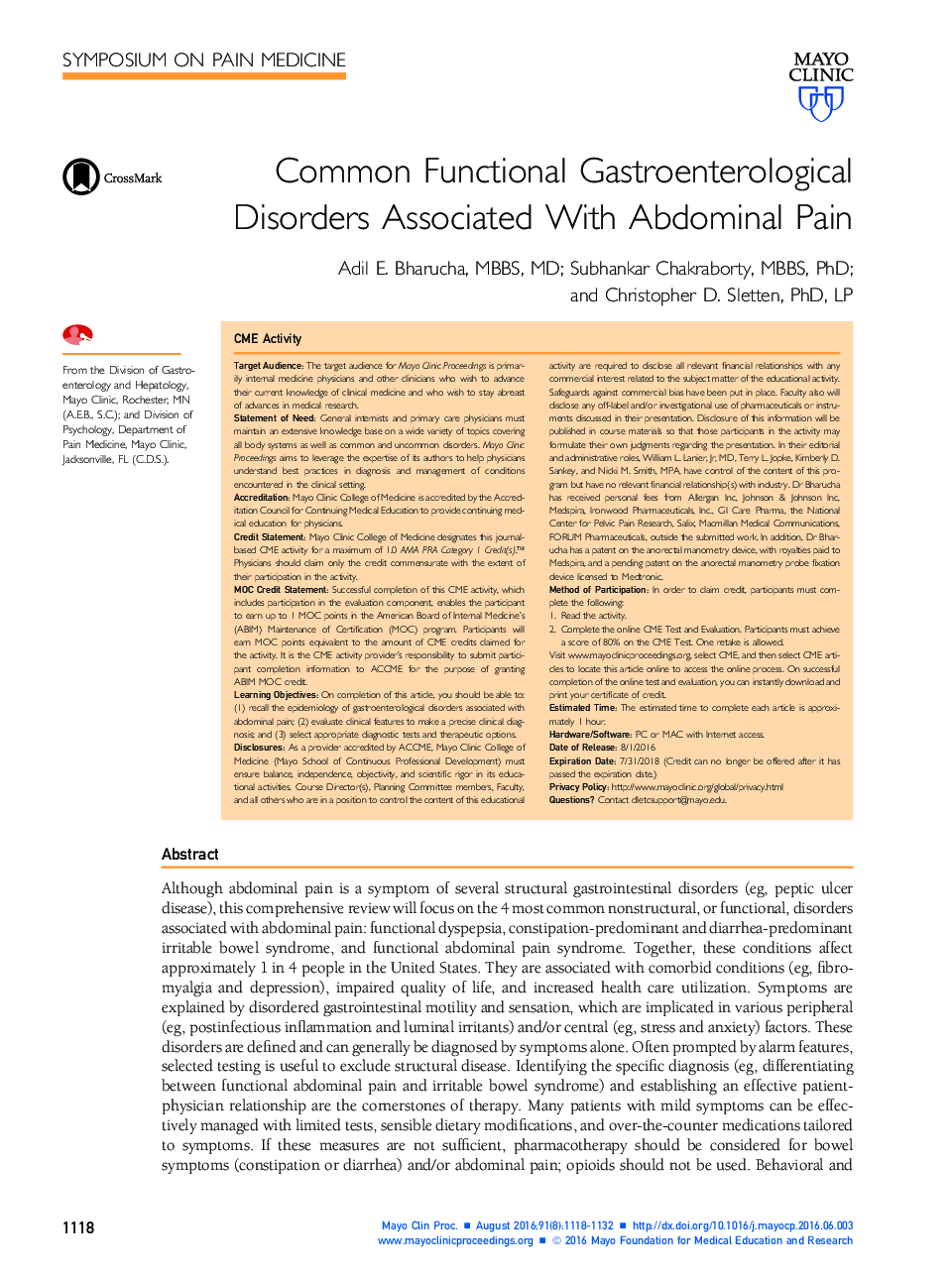| کد مقاله | کد نشریه | سال انتشار | مقاله انگلیسی | نسخه تمام متن |
|---|---|---|---|---|
| 10165417 | 1180232 | 2016 | 15 صفحه PDF | دانلود رایگان |
عنوان انگلیسی مقاله ISI
Common Functional Gastroenterological Disorders Associated With Abdominal Pain
ترجمه فارسی عنوان
اختلالات گوارشی عملکردی متداول مرتبط با درد شکم
دانلود مقاله + سفارش ترجمه
دانلود مقاله ISI انگلیسی
رایگان برای ایرانیان
کلمات کلیدی
5-HTTCA5-hydroxytryptamineIBSNBSSNRIOICOBDTricyclic antidepressant - داروهای ضدافسردگی سه حلقه ایGastrointestinal - دستگاه گوارشirritable bowel syndrome - سندروم روده تحریک پذیر، کولیت عصبیSelective serotonin reuptake inhibitor - مهار کننده بازجذب سروتونین انتخابیSerotonin and norepinephrine reuptake inhibitor - مهارکننده بازجذب سروتونین و نوراپی نفرینSSRI - مهارکنندههای بازجذب سروتونینOpioid-induced constipation - یبوست ناشی از یبوست
ترجمه چکیده
اگر چه درد شکم یک نشانه از اختلالات ساختاری دستگاه گوارش است (به عنوان مثال، بیماری زخم معده)، این بررسی جامع در مورد 4 اختلال غیراختصاصی یا اختلالات عملکردی مرتبط با درد شکمی تمرکز دارد: اختلال عملکردی، غالب یبوست و اسهال غالب سندرم روده تحریک پذیر و سندرم درد شکمی عملکردی. با هم، این شرایط حدود 1 در 4 نفر در ایالات متحده تاثیر می گذارد. آنها با شرایط همراه (مانند فیبرومیالژیا و افسردگی)، کیفیت زندگی و کیفیت مراقبت های بهداشتی افزایش می یابد. علائم همراه با تحرک و حساسیت گوارشی اختلال است که در محیط های مختلف (مانند التهاب پس از التهاب و تحریک کننده های لومینا) و / یا عوامل مرکزی (مثلا استرس و اضطراب) دخیل هستند. این اختلالات تعریف شده و به طور کلی تنها با علائم تشخیص داده می شوند. اغلب از ویژگی های زنگ هشدار دهنده، تست انتخاب شده برای حذف بیماری های ساختاری مفید است. شناسایی تشخیص خاص (به عنوان مثال، تمایز بین درد شکم شکم و سندرم روده تحریکپذیر) و ایجاد رابطه مؤثر بیمار و پزشک، سنگ بنای درمان است. بسیاری از بیماران مبتلا به علائم خفیف می توانند به طور مؤثر با آزمایش های محدود، تغییرات در رژیم غذایی معقول و داروهای بدون نسخه به منظور علائم درمان شوند. اگر این اقدامات کافی نیست، داروی درمان باید برای علائم روده (یبوست یا اسهال) و / یا درد شکم مورد توجه قرار گیرد. مواد مخدر نباید استفاده شود رویکرد رفتاری و روانی (به عنوان مثال، درمان شناختی رفتاری) می تواند مفید باشد، به ویژه در بیماران مبتلا به درد مزمن شکم که نیاز به برنامه مدیریت درد چند رژیمی بدون مهاری دارند.
موضوعات مرتبط
علوم پزشکی و سلامت
پزشکی و دندانپزشکی
کاردیولوژی و پزشکی قلب و عروق
چکیده انگلیسی
Although abdominal pain is a symptom of several structural gastrointestinal disorders (eg, peptic ulcer disease), this comprehensive review will focus on the 4 most common nonstructural, or functional, disorders associated with abdominal pain: functional dyspepsia, constipation-predominant and diarrhea-predominant irritable bowel syndrome, and functional abdominal pain syndrome. Together, these conditions affect approximately 1 in 4 people in the United States. They are associated with comorbid conditions (eg, fibromyalgia and depression), impaired quality of life, and increased health care utilization. Symptoms are explained by disordered gastrointestinal motility and sensation, which are implicated in various peripheral (eg, postinfectious inflammation and luminal irritants) and/or central (eg, stress and anxiety) factors. These disorders are defined and can generally be diagnosed by symptoms alone. Often prompted by alarm features, selected testing is useful to exclude structural disease. Identifying the specific diagnosis (eg, differentiating between functional abdominal pain and irritable bowel syndrome) and establishing an effective patient-physician relationship are the cornerstones of therapy. Many patients with mild symptoms can be effectively managed with limited tests, sensible dietary modifications, and over-the-counter medications tailored to symptoms. If these measures are not sufficient, pharmacotherapy should be considered for bowel symptoms (constipation or diarrhea) and/or abdominal pain; opioids should not be used. Behavioral and psychological approaches (eg, cognitive behavioral therapy) can be helpful, particularly in patients with chronic abdominal pain who require a multidisciplinary pain management program without opioids.
ناشر
Database: Elsevier - ScienceDirect (ساینس دایرکت)
Journal: Mayo Clinic Proceedings - Volume 91, Issue 8, August 2016, Pages 1118-1132
Journal: Mayo Clinic Proceedings - Volume 91, Issue 8, August 2016, Pages 1118-1132
نویسندگان
Adil E. MBBS, MD, Subhankar MBBS, PhD, Christopher D. PhD, LP,
